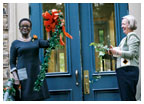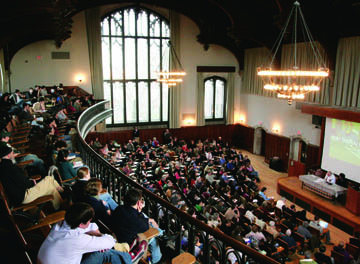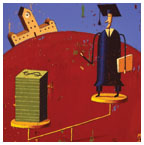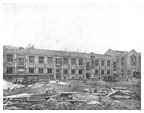
|
October 24, 2007: Notebook
A focus on schools
Research mixes education with economics
Seeing green: Local farmers come to campus
A century of McCosh Hall: Memorable moments
Cecilia Rouse (Illustration: Martin Jarrie; photo: Jon Roemer/Courtesy Woodrow Wilson School) |
A
focus on schools
Research mixes education with economics
Last spring, Princeton economists Cecilia Rouse and Jesse Rothstein released a working paper about the effects that debt, or the absence of debt, can have on the career choices of recent college graduates. Using data from an anonymous university that adopted a no-loan policy in 2001 (the year that Princeton moved from loans to grants), the authors found what Rothstein calls a “surprisingly large” change: About 5 percent of the students who benefited from the reduction of loans shifted to relatively low-paid jobs in education, government, or nonprofit organizations.
While a noneconomist might see the shift as intuitive, Rothstein says, “The economic models that we usually work from would imply that [the no-loan policy] shouldn’t have much of an effect.” Student-loan debt, when viewed as a portion of lifetime earnings, is a minor expense that should not affect career decisions, Rothstein explains. But that view may not account for short-term constraints on credit. If a student borrows $20,000 for college, he or she will not be able to borrow as much when deciding to buy a car or a home. Those credit constraints, Rothstein says, are the most plausible explanation for the difference in career choices observed in the data.
Combining economics with topics in education is nothing new for Rothstein, an assistant professor of economics and public affairs, or Rouse, the Theodore A. Wells ’29 Professor of Economics and Public Affairs. Rothstein has co-authored an analysis of affirmative action in law-school admissions, which found, among other things, that eliminating affirmative action could cut the number of black law students by half. Rouse’s ongoing projects include an extensive, six-year study of an accountability system in Florida’s public schools. Preliminary findings have shown that schools that received failing grades responded by focusing more on low-performing students, and student test scores improved in each of the three following years.
Education, Rouse says, fits into the field of economics because it plays an important role in human capital, which in turn shapes a nation’s economy. Both Rouse and Rothstein work in the University’s Education Research Section (ERS), an affiliation of social scientists who study education at all levels. Rouse, the section’s founder and director, started the group five years ago when she noticed several pockets of interesting education research at Princeton.
While most of the researchers knew about the work being done elsewhere on campus, she says, “What was missing was the public-service aspect.” They were connecting with each other, but not with the people who actually determine education policy. So in addition to drawing researchers together, ERS reaches out to policymakers — mostly public school superintendents and administrators — with an annual spring conference that covers leading research and practices in schools. Last spring, the focus was on strengthening the teacher workforce. This year, researchers and administrators will examine how media and technology affect children.
While bridging research and practice can have positive effects, Rouse
says that some uncertainty is inevitable. For instance, Rouse and colleagues
Lisa Barrow *99 and Lisa Markman studied computer-aided instruction in
algebra and pre-algebra in three school districts. On average, students’
math scores improved, but in one district, they declined. “There
are limits to any study,” Rouse says. “Research doesn’t
answer all the questions.” ![]()
By B.T.

Students and members of the community stock up on locally grown produce during the Greening Princeton farmers’ market Sept. 25 in Firestone Plaza. (Frank Wojciechowski) |
Seeing green: Local farmers come to campus
Parents concerned about their children’s eating habits at college can breathe a sigh of relief. For Princetonians, pecorino is the new pizza.
At the University’s first student-organized farmers’ market Sept. 25, the line for cheese at the Valley Shepherd Creamery booth was more than 15 people deep.
“No nettles?” cried a dismayed Grant Gittlin ’08 when he’d reached the front of the line. “You’re killing me, man.”
Gittlin was hoping for a taste of the creamery’s signature creation, a mixed-milk cheese flavored with stinging nettles. He settled for a round of organic sheep’s milk chèvre.
“I’m going to get my George Foreman grill and some health nut bread,” Gittlin explained. “I’ll put some cheese in the bread — maybe a mélange of cheeses — then grill it up for a late-night snack.”
Students, faculty, staff, and community members filled the sun-drenched courtyard outside Firestone Library, hoping for a taste of the organic
foods for sale by local farmers. The farmers’ market was scheduled to return to the plaza on the following four Tuesdays.
At the Honeybrook Organic Farm stand, Daphne Oz ’08 picked out yellow heirloom tomatoes the size of pumpkins, fresh lettuce, and organic radishes. A few moments later, she was slicing the ingredients for a farm-fresh lunch salad. Nearby, chefs from University Dining Services offered a cooking demonstration, using ingredients from local producers and herbs grown by Princeton students to whip up a tomato and crouton salad.
Although Posie Harwood ’09 confessed to gorging herself on bread and cheese from the market, she said she had come for more than just the food. “I really like going to the farmers’ market for the community feel,” she said. “There’s a happy vibe being there — seeing students coming and getting stuff, people from the town coming, teachers coming, and everyone mingling with the vendors. Underlying that is the idea that people are buying and getting into healthy, organic food.”
Gittlin also appreciated the market for bringing people together in celebration of local produce and organic foods. “Everyone’s in a rush. It’s nice to take a step back and see people who take the time to enjoy good food in their daily life,” he said.
While the market’s first day was a success, Princeton students
have a long way to go in terms of making educated, sustainable decisions
about food, said Katy Andersen ’08, the co-organizer of the event.
“I think most students just want to eat food that tastes good without
thinking about where it comes from,” Andersen said. ![]()
By Bianca Bosker ’08

 |
Professor Valerie A. Smith, left, the director of the Center for African
American Studies, and President Tilghman on the steps of Stanhope Hall
after a ceremonial ivy-cutting Oct. 2 to mark the center’s relocation
to the newly renovated hall. Saying that African American studies is a
program “for every Princeton student,” Tilghman noted that
it is located “at the heart” of the University both physically
and intellectually. Stanhope, the University’s third-oldest building,
was built in 1803; it is located just steps away from Nassau Hall. The
Program in African American Studies began in 1969; it became a center
a year ago when plans were announced for a major expansion of faculty
and course offerings. ![]()

McCosh Hall, above, shortly before its completion in 1907. Below, McCosh 50 continues to be a popular spot on the lecture circuit. (Denise Applewhite/Office of Communications; May 8, 1907, Princeton Alumni Weekly)
|
A century of McCosh Hall: Memorable moments
From its opening in September 1907 through the start of classes this year, McCosh Hall has played a significant role in Princeton’s academic life, hosting courses, seminars, precepts, and public events, including talks by Nobel laureates, diplomats, authors, and at least one supermodel.
Designed by Raleigh Gildersleeve, the hall was built as a memorial to James McCosh, Princeton’s president for 20 years in the period after the Civil War. At the time, it was the largest building on campus. McCosh Hall originally held 44 rooms but was extended in the early 1920s, after a fire destroyed nearby Dickinson Hall. Today, McCosh is best known for its large lecture halls, though it also houses faculty in the English department and the Program in American Studies.
In recognition of McCosh’s centenary, PAW has gathered quotes
and comments offered to Princeton audiences in the stately hall by notable
figures. ![]()
By B.T.

“There can be nothing more disruptive of our success in every great area of foreign policy than the impression ... that we are prepared to sacrifice the traditional values of our civilization to our fears rather than defend those values with our faith.”
George F. Kennan ’25, speaking about foreign policy and the McCarthy era, March 1954
“The object of all science, whether natural science or psychology, is to coordinate our experiences and to bring them into a logical system.”
Albert Einstein, in his lectures on relativity, May 1921 (translated from German)
“I say to you that in spite of the fact that I have all the reasons in the world to give up on humanity, I won’t. ... Despair is never an option.”
Elie Wiesel, delivering the Walter E. Edge Lecture, September 2005
“It was like entering a dark mansion. You fumble around in a completely dark room for a couple of years. You bump into the furniture looking for the light switch. When you find it, you move to the next room.”
Mathematics professor Andrew Wiles, on solving Fermat’s Final Theorem, May 1995
“We began to prove about 20 years ago that women can do what men can do. Now it must be demonstrated that men can do what women can do.”
Gloria Steinem, in a speech about feminism and activism, December 1997
“I have yet to find a state constitution that begins, ‘We the some of the people ... .’”
Thurgood Marshall, delivering the Stafford Little Lectures, February 1964
“There is everlasting repetition in human beings. Everything inside of everyone is endlessly different yet endlessly the same ... . The history of everyone is the history of anyone.”
Gertrude Stein, on “The making of the making of Americans,” November 1934

Illustration by Steven Veach |
R U voting? A short, direct text message can help bring young voters to the polls, according to a recent study by Princeton politics Ph.D. candidate Aaron Strauss and Allison Dale, a Ph.D. student at the University of Michigan. During the 2006 midterm election, Strauss and Dale monitored the effects that reminders sent via text messaging had on more than 8,000 young voters who provided cell phone numbers during registration drives. More than 56 percent of those who received messages on their cell phones turned out at the polls, compared with about 53 percent in the control group. While that may seem like a modest difference, the authors note that another factor could draw campaigns to the technology: A rough calculation of the cost of each vote generated suggests that sending text messages is far cheaper than running a traditional phone bank.
Sun-damental In August, working in an isolated laboratory
beneath the mountains of Italy, a Princeton team led by physics professor
Frank Calaprice gained a clearer understanding of sunshine by making the
first real-time detection of low-energy solar neutrinos, according to
the National Science Foundation. Calaprice, his Princeton colleagues,
and a group of international collaborators detected the particles, which
are produced in the core of the sun, using the Borexino detector, a finely
tuned 59-foot-wide spherical device that can detect subatomic particles.
The observations “essentially confirm that we understand how the
sun shines,” Calaprice said in a University release. “Physicists
have had theories regarding the nuclear reactions within the sun for years,
but direct observations have remained elusive,” he said. “Now
we understand these reactions much better.” ![]()

(Frank Wojciechowski) |
Work continues on the Lewis Science Library, with its Frank Gehry-designed
curving forms clearly visible on Washington Road at Ivy Lane. Construction
began in November 2004, and the original completion date was last December.
University spokeswoman Cass Cliatt ’96 said it is a “priority”
to complete the building in the fall of 2008, but that no specific date
has been set. Peter B. Lewis ’55 donated $60 million toward the
building; University treasurer’s reports have put the total cost
at $73 million. ![]()

 MICHAEL
ELOWITZ *99, a molecular biologist who is an assistant professor
of biology and applied physics at Caltech, is one of 24 MacArthur Fellows
announced Sept. 25. Elowitz was cited by the MacArthur Foundation for
“laying the groundwork for the next stage in the genomics revolution
— understanding how genes interact.” In his research, he designs
and tests artificial genetic circuits. The fellowships, known as “genius”
grants, recognize exceptional creativity; each fellow receives a five-year
grant of $500,000, with no strings attached. Among the other recipients
is Claire Kremen, an assistant professor at the University of California,
Berkeley, who was an assistant professor of ecology and environmental
biology at Princeton from 2001 to 2005.
MICHAEL
ELOWITZ *99, a molecular biologist who is an assistant professor
of biology and applied physics at Caltech, is one of 24 MacArthur Fellows
announced Sept. 25. Elowitz was cited by the MacArthur Foundation for
“laying the groundwork for the next stage in the genomics revolution
— understanding how genes interact.” In his research, he designs
and tests artificial genetic circuits. The fellowships, known as “genius”
grants, recognize exceptional creativity; each fellow receives a five-year
grant of $500,000, with no strings attached. Among the other recipients
is Claire Kremen, an assistant professor at the University of California,
Berkeley, who was an assistant professor of ecology and environmental
biology at Princeton from 2001 to 2005.
It took $1 billion in net worth to make Forbes’ list of the 400 RICHEST AMERICANS this year, and The Daily Princetonian combed the list to find 10 Princeton alumni. Carl Icahn ’57, a financier and private equity investor, ranked 18th with an estimated net worth of $14.5 billion. Amazon founder and CEO Jeff Bezos ’86 ranked 35th with $8.7 billion, while Google CEO Eric Schmidt ’76 was 48th with $6.5 billion. Other Princetonians on the list, with their rank and estimated net worth: industrialist Henry Hillman ’41, 117, $3 billion; Peter Briger Jr. ’86 and Michael Novogratz ’87, co-presidents of Fortress Investment Group, 317, $1.5 billion; John Fisher ’83, president of Pisces Inc., also 317 and $1.5 billion; Fisher’s brothers, Robert ’76, chairman of Gap Inc., and William ’79, managing partner of Manzanita Capital, both ranked 361 with $1.4 billion; and Meg Whitman ’77, president and CEO of eBay, also 361, $1.4 billion.
The members of COLONIAL CLUB will perform community service work as part of a plea agreement in municipal court in which the club admitted serving alcohol to an underage female student during Houseparties in May. Borough police originally charged the club’s undergraduate president, but Llewellyn Ross ’58, chairman of the club’s graduate board, said the club felt strongly that it would not be fair for one individual to be singled out for punishment. He also said the club has been vigilant in its effort to prevent underage drinking. As a result of the plea agreement, club members will perform 500 hours of community service and the club has paid a “modest” fine, Ross said. “This is a good price to pay,” Colonial attorney Robert Wills told The Daily Princetonian. “It’s going to help the community and help the club build stronger ties with the community.”
The University has begun a search for a new chief medical officer and head of health services. DANIEL SILVERMAN, named to the position in August 2002, has resigned to become a senior director of Keeling & Associates, a New York-based higher education consulting firm. Janet Finnie ’84, who has been director of operations and associate director of University Health Services since 2000, has been named interim director.
Forcible sex offenses at Princeton have increased from three in 2004
to 17 in 2006, according to the University’s latest annual SECURITY
REPORT. Cass Cliatt ’96, University spokeswoman, said officials
don’t believe the figures point to a sharp increase in incidents
on campus. Suraiya P. Baluch, director of the Sexual Harassment/Assault
Advising, Resources, and Education (SHARE) office within University Health
Services, said the numbers show that more victims are coming forward and
seeking help. If the increase “does shock people,” she said,
that would support SHARE’s programs to promote awareness on the
campus and in the clubs. The annual report cited 22 drug-abuse violations,
up from the previous two years, while liquor-law violations, at 20, dipped
slightly. There were no reports of murder, manslaughter, aggravated assault,
or robbery in 2006. ![]()






